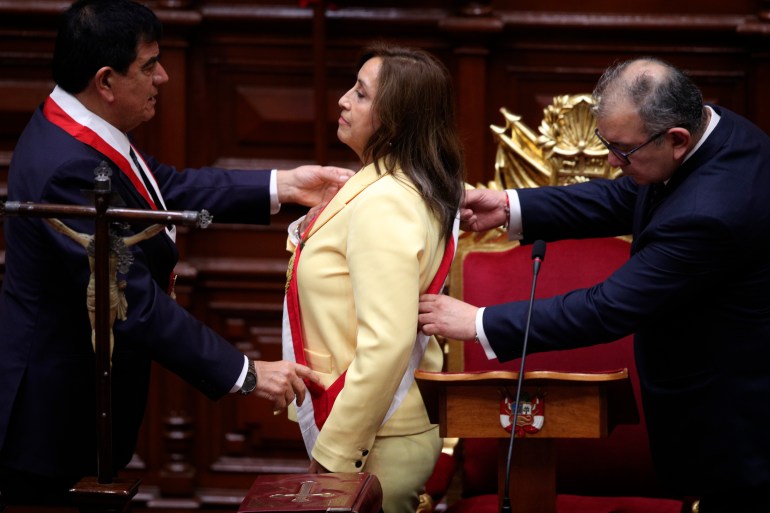Why was Peru President Pedro Castillo impeached?
Congress votes to remove Castillo after he sought to rule by decree. He was replaced by his deputy Dina Boluarte.

Peru’s former President Pedro Castillo has been arrested after he was removed from office by the Congress in an impeachment trial.
Left-wing leader Castillo announced on Wednesday that he was dissolving the Congress, introducing a curfew and using emergency powers to call new elections.
Keep reading
list of 4 itemsPeru’s Pedro Castillo blasts critics ahead of impeachment hearing
A look at years of political chaos in Peru
Peru’s PM resigns after confidence vote refused
The move was condemned by the constitutional court as a “coup d’etat” and legislators soon gathered and overwhelmingly voted in favour of removing Castillo.
The former president was later arrested and accused of the crimes of “rebellion” and “conspiracy” for breaking the constitutional order.
Hours after the impeachment, Vice President Dina Boluarte was sworn in as Peru’s new president.
Let us take a closer look at how the dramatic events unfolded in Peru and what could happen next.
Why was Castillo impeached?
Castillo announced plans to “temporarily” dissolve the legislature and rule by decree to “re-establish the rule of law and democracy” in Peru.
The move was widely condemned as an attempted “coup”. Several government ministers resigned in protest and the Congress quickly held an impeachment trial, overwhelmingly voting to remove Castillo with 101 votes out of a total of 130.
“We condemn the violation of constitutional order,” federal prosecutors said in a statement.
“Peru’s political constitution enshrines the separation of powers and establishes that Peru is a democratic and sovereign Republic … No authority can put itself above the Constitution and must comply with constitutional mandates.”
It was the third time that Castillo faced an impeachment attempt since he came to office in July 2021.
The latest legal battle began in October when the prosecutor’s office filed a constitutional complaint alleging that Castillo was leading a “criminal organisation” that benefitted from state contracts and obstructed investigations.
Peru’s Congress had issued a summons for Castillo last week over allegations of corruption that he rejected, accusing his rivals of trying to “blow up democracy and disregard our people’s right to choose”.
Why was Castillo in conflict with Congress?
The government of Castillo, a former rural school teacher, suffered from political instability for months. He and members of his family are facing six corruption investigations. He has denied any wrongdoing.
Castillo previously survived two impeachment attempts, the first of which came last December. At the time, a relatively small group of opposition lawmakers cited an investigation by prosecutors into illicit financing of the governing party. To remove the president requires two-thirds of the 130 lawmakers to vote in favour. Only 46 voted in favour.
Congress tried to impeach Castillo again in March for “permanent moral incapacity”, a term incorporated into Peruvian constitutional law that experts say lacks an objective definition and that Congress has used more than half a dozen times since 2017 to try to remove presidents. The effort failed, this time with only 55 votes in favour.
In October, five of Castillo’s allies were detained on corruption charges. In August, his sister-in-law, Yenifer Paredes, was given 30 months of pre-trial detention. Prosecutors alleged that Paredes was involved in a scheme to hand contracts to allies of the president in his home region. She has not been charged with a crime.
In November, Castillo accepted the resignation of then-prime minister and strong ally, Anibal Torres, marking the departure of the fourth prime minister in Castillo’s term.
Torres had challenged Congress to hold a confidence vote and stepped down after the legislative body declined to do so.
Castillo ran on a left-wing platform that promised a fairer economic system, but he has largely governed as a moderate.
In November, thousands of demonstrators took to the streets of Peru’s capital to call for the resignation of Castillo.
Castillo has previously said he was the victim of a campaign to remove him from power.

Why was Castillo arrested?
After the impeachment vote, Castillo was arrested as he was travelling to the Mexican embassy to request asylum, according to a police report published by the local press.
Videos circulating on social media appeared to show police intercepting his car to take him into custody.
The Public Ministry said on Wednesday that Castillo had been arrested on charges of the crimes of “rebellion” and “conspiracy” for breaking the constitutional order.
Castillo was transferred to a police facility in eastern Lima where corruption-convicted former President Alberto Fujimori, who was removed by Congress in 2000, is serving out his sentence.
Hundreds of people protested following the impeachment, some of whom supported the former president, while others celebrated the removal.

Who is the new president?
Following the impeachment, Boluarte, 60, was sworn in as the new president. She is a lawyer by training and Peru’s first female president.
“I request a political truce to install a government of national unity,” she said in her first speech as Peru’s sixth president in just five years.
“I ask for time, valuable time to rescue the country from corruption and misrule,” she said, adding that a new cabinet will be inclusive of all political sides.
Boluarte criticised Castillo’s move to dissolve Congress as an “attempted coup”.
She had distanced herself from Castillo in recent weeks and resigned from her role as a cabinet minister.
Boluarte has proven to be someone who “goes with the flow”, said analyst Andres Calderon, noting how she quickly distanced herself from her socialist party’s polarising Marxist founder Vladimir Cerron.
